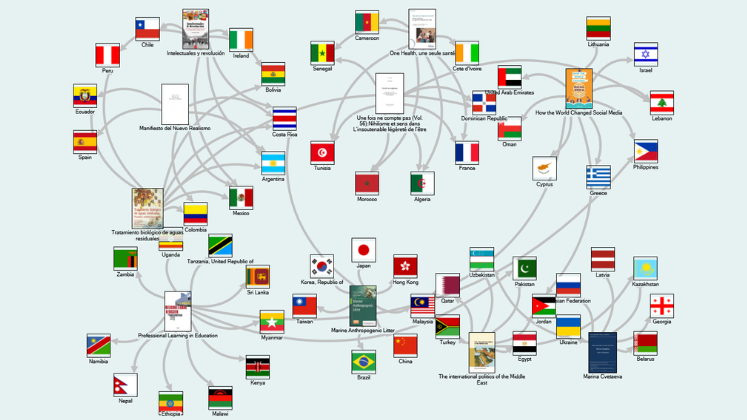Drawing on findings from a new survey of equity, diversity, inclusion and belonging policies in European academic publishing, Lynne Bowker, Mikael Laakso, Janne Pölönen, and Claire Redhead outline the intersectional nature of scholarly communication’s diversity challenge and present new resources for actors across the system to implement changes.
Scholarly publishing is a complex and multifaceted industry involving many different actors. Over the years, a variety of practices have emerged or been established, often with good intentions, that have resulted in persistent disparities. These disparities are well documented. Now is the time to take action to improve various aspects of equity, diversity, inclusion and belonging (EDIB) in scholarly communication.
The unintended consequences of English as the central language of science
In an effort to facilitate global conversations in research, scientists began using English as a common language for scholarly communication. However, over time, it became clear that this decision afforded privileges to some groups while creating barriers for others. Native speakers of English are able to read and write more quickly in this language, while speakers with a lower proficiency need to invest more effort and may receive a higher proportion of rejected manuscripts. Further, in a system where English is used as the central language, authors are not the only ones who need to be highly proficient: peer reviewers and editorial boards must also have a solid grasp of the language. And so, native English speakers, who mainly hail from a handful of Western countries, began taking on these roles in disproportionate numbers, while scholars from other regions had fewer opportunities to do so.
Editors and editorial board members have a strong voice when it comes to shaping the focus of a journal. With so many voices from a select few regions steering the direction of international journals, it is not too surprising to learn that topics considered to be interesting for an international audience may in fact be topics that are primarily of interest to those same Western regions. So, if English speakers are able to be more productive and are working on topics more likely to be accepted in international journals, they are bound to publish more. And with more publications out there, they are also likely to be cited more often. As their H-indexes grow, they may qualify for promotions, awards and prestigious positions and affiliations. And while this may not have been the intention behind selecting a single language for scholarly communication, it has unfortunately become a result.
Intersectional bias in scholarly communication
Lack of diversity in scholarly communication shows up in other ways, such as in relation to gender. It has been observed that women are less likely than men to be lead or corresponding authors, less likely to be cited, and less likely to be peer reviewers or editorial board members. As is the case for non-Anglophone scholars, women researchers end up with lower profiles and fewer opportunities. Adding to the overall problem, the effects of various types of disparity can be intersectional and cumulative. For instance, a scholar who identifies as a Black, non-Anglophone, disabled woman can be marginalised on multiple fronts. If these problems are now coming into sharper focus, the solutions are only starting to emerge.
Scholarly publishers, like research and higher education institutions, are expected to consider the diversity and pluralism of stakeholders’ backgrounds. The DIAMAS (Developing Institutional open Access publishing Models to Advance Scholarly communication) institutional publishing landscape report, Institutional Publishing in the ERA: Results from the DIAMAS Survey, is based on 685 survey responses from institutional publishers and publishing service providers across the European Research Area. The report shows that addressing EDIB is far from a standard practice (Fig.1). Given that more than half of the respondents (54%) were not implementing measures to address any of the EDIB dimensions, awareness-raising and support is much needed.

Fig.1: According to the landscape report Institutional Publishing in the ERA: Results from the DIAMAS Survey, language (30%) and gender (29%) are the main EDIB dimensions that the 685 European institutional publishers and publishing service providers have already begun to address. Source: https://zenodo.org/records/10022184
Surveying best practice
To help raise awareness and provide new courses of action to improve EDIB in scholarly communication, the DIAMAS project is developing an Extensible Quality Standard for Institutional Publishing (EQSIP) v2.0 for Diamond Open Access, which includes EDIB as a core component. The overall objective of EQSIP for Diamond Open Access is to set a common quality standard for institutional publishers that publish scholarly journals, based on the seven core components of scholarly publishing as outlined in the Action Plan for Diamond Open Access, which were revised and modified by the DIAMAS team. In the current version, substantial parts of EQSIP provide recommendations concerning linguistic and gender diversity, as well as accessible and inclusive websites. The group responsible for the EDIB component has combed the available academic and grey literature to identify tips, recommendations, good practices and policies that have been put forward by different actors to improve EDIB in the scholarly communication ecosystem. The content has been organised into two types of fully open resources:
- Toolsuites: The four toolsuites for EDIB include an overarching toolsuite for EDIB, as well as more focused toolsuites for multilingualism, gender diversity, and accessible/inclusive websites. The toolsuites are in the form of a 500-word narrative that introduces the issue, presents some of its consequences, and outlines some potential directions for addressing it. The toolsuites also contain references, keywords, links to a glossary and further reading, and some frequently asked questions. Finally, the toolsuites also contain cross-references to related toolsuites and links to the guidelines and training resources that have been developed by the DIAMAS team.
- Guidelines: These materials are practically oriented resources aimed at the main actors involved in scholarly publishing: authors/researchers; peer reviewers; editors, associate editors and editorial board members; librarians; journal publishers; and book publishers. The recommendations come in the form of bullet points organized into short- medium- and long-term goals, along with links to examples or additional information. Guidelines are available for multilingualism, gender diversity, and accessible/inclusive websites.
The DIAMAS toolsuites and guidelines will not solve all the EDIB-related problems overnight, but they represent a concrete step towards improving the situation by offering material for both reflection and action by a range of different players involved in scholarly publishing. Why not check them out and see if there are actions that you can take to bring more equity, diversity, inclusion and belonging to your corner of scholarly communication?
The content generated on this blog is for information purposes only. This Article gives the views and opinions of the authors and does not reflect the views and opinions of the Impact of Social Science blog (the blog), nor of the London School of Economics and Political Science. Please review our comments policy if you have any concerns on posting a comment below.
Image Credit: Tim Mossholder via Unsplash.








An important article highlighting the issue of diversity in academic communication and the challenges for non-English speaking researchers. The article encourages the adoption of inclusive practices in academic institutions to improve diversity. Thank you very much.
https://just.edu.ye/ar/scholarjanad/categories